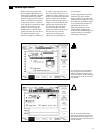
18
The AWG’s graphical waveform
editor provides a variety of
mathematical operators for exist-
ing waveforms. Waveforms can
be combined with other
waveforms, or a waveform can
be squared, scaled, differenti-
ated, integrated, etc.
Combining the Noise
with the Carrier
The signal and noise waveforms
are summed using the AWG’s
waveform editor (Figure 19).
The spectra of the 32K point
waveform and the 256K point
waveform are overlaid in
Figure 20. Recall that the period
of the 32K point waveform is
1 ms. You can see that the noise
“floor” of the spectrum of the
32K point waveform is a series
of discrete components spaced
1 kHz apart. Thus, even though
the objective is to define signal
waveforms with the minimum
number of record points, noise
waveforms should be created
with the maximum number of
record points! The two objec-
tives are resolved by creating a
longer version (to match the
noise record length) of the signal
waveform by sequencing multiple
copies of itself.
Frequency (kHz
-90
-80
-70
-60
-50
-40
-30
-20
10670 10680 10690 10700 10710 10720 10730
Figure 20. Spectrum analyzer plots of the
32K point FM carrier plus noise (lighter) and the
256K point FM carrier plus noise. Longer noise
waveforms repeat less often so the noise density
characteristics will be flatter.
Figure 19. The 32K point FM waveform is added
to the 32K point noise waveform.
Magnitude (dBm)


















